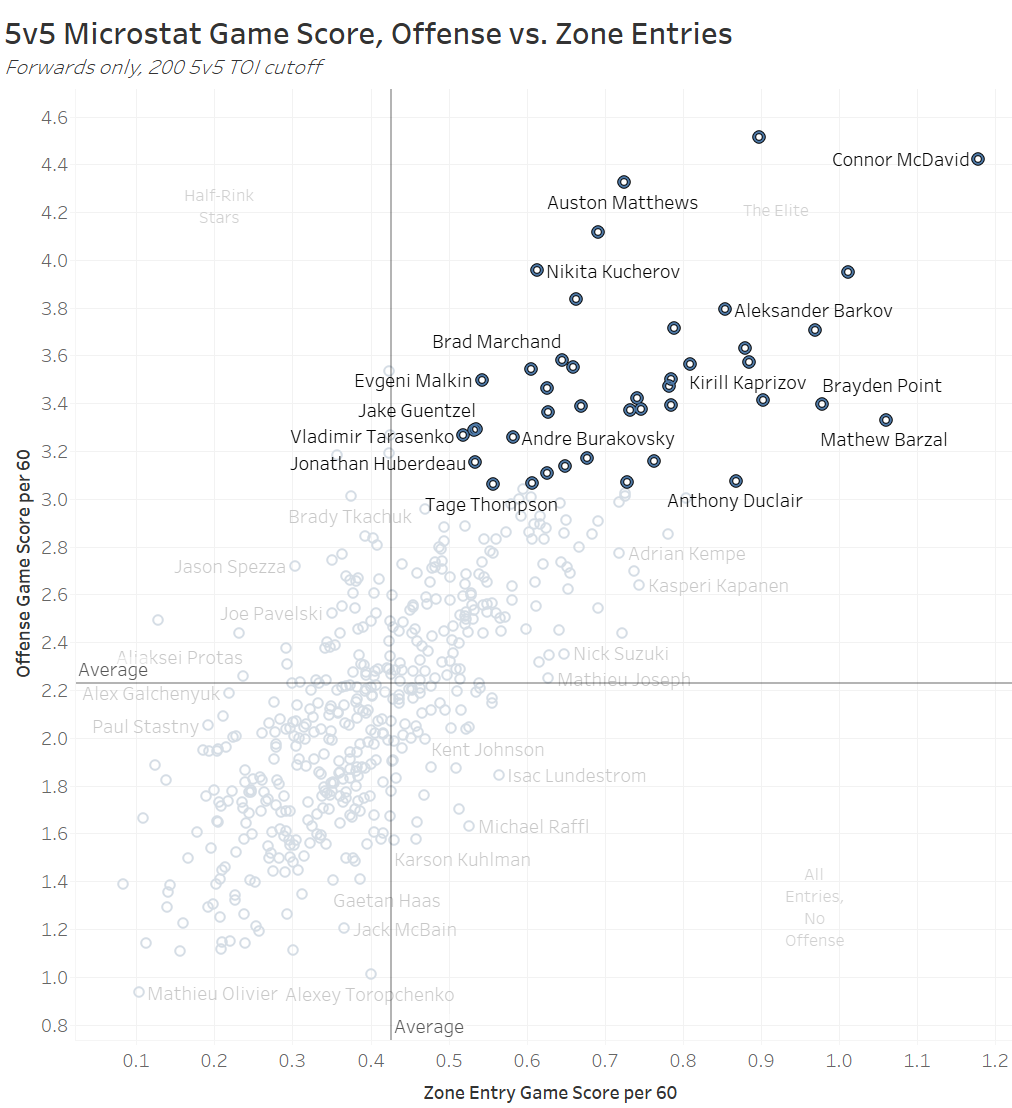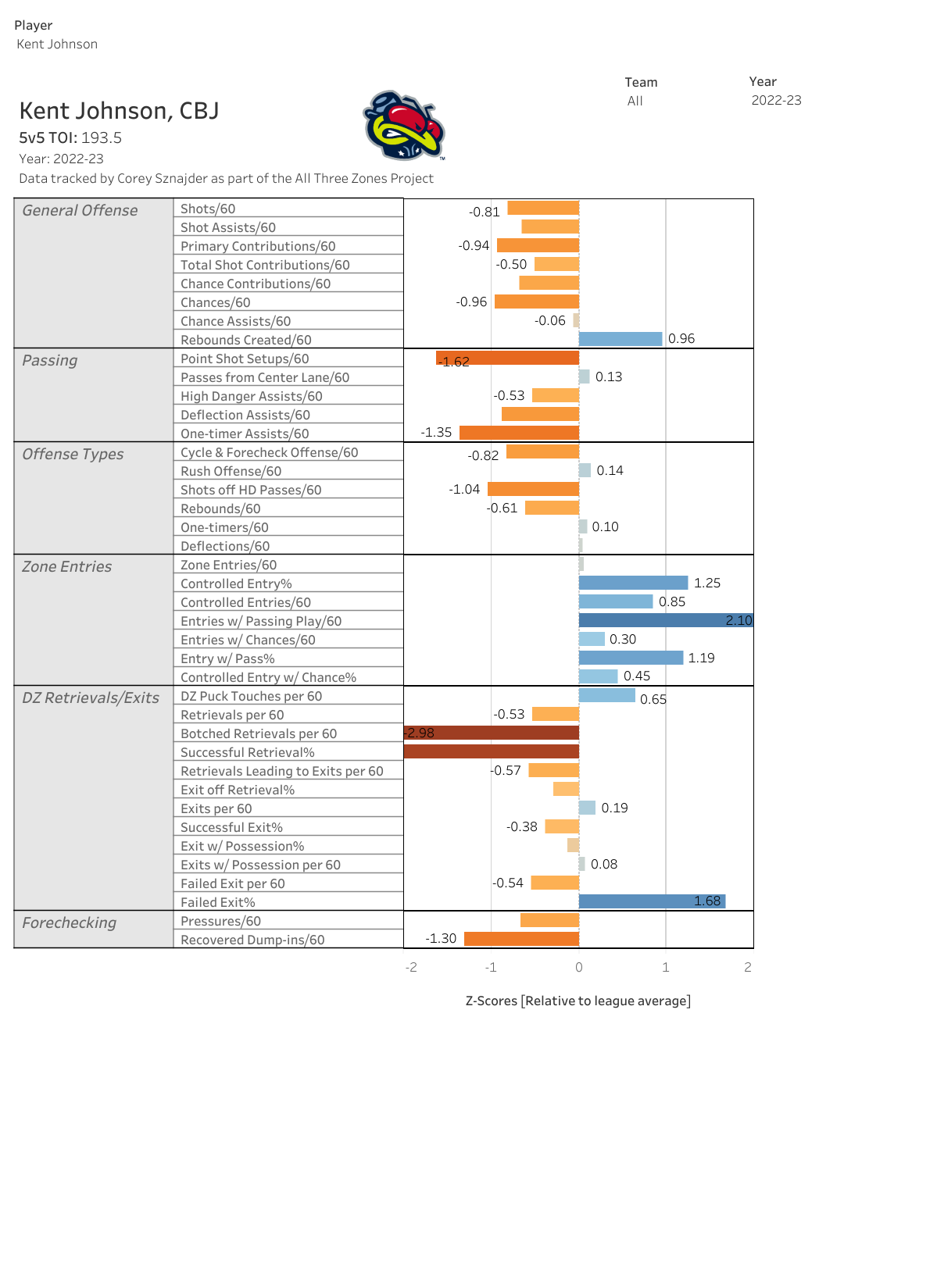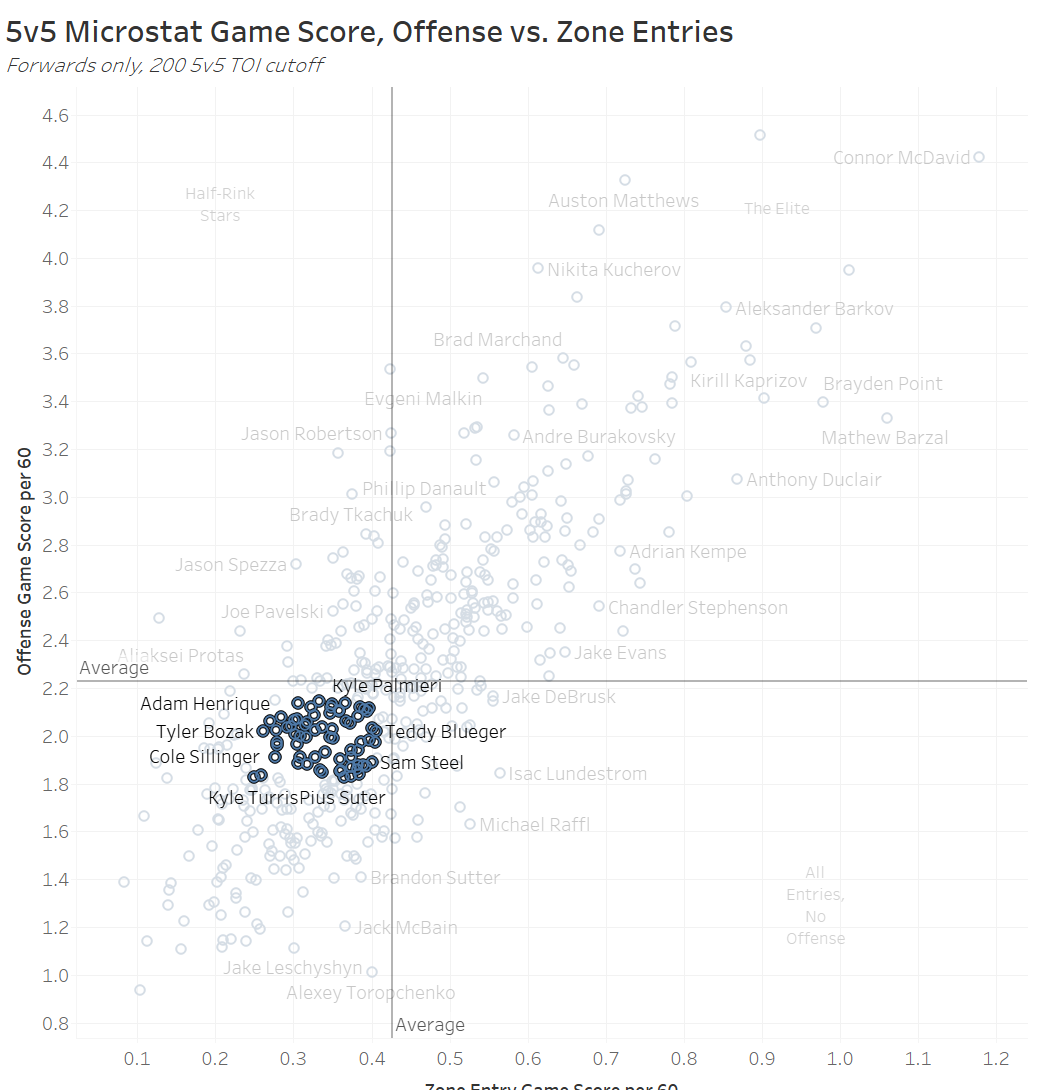The Microstat Player Compass
Exploring the different layers of the A3Z data
A common misconception I see with the All Three Zones project (and microstats in general) is that zone entries & zone exits are how you judge if a player is good or not. Don’t get me wrong, that’s how this project began and the Nikolaj Ehlers & Mathew Barzals of the league are always going to be rated higher by these stats than others. It just isn’t the only thing you look for when using microstats.
There are a lot of components that go into hockey & transition play is a big part of it. Players who are good at zone entries are usually going to produce offensively or become useful players at some level. About 50% of goals are still scored off the rush, whether it’s by transition or off counter-attacks & you need players who help you break through coverage & create offense that way. It’s also a skill that’s easy to identify in players early. You only get so many puck touches as a rookie & those who show this skill in their first couple of years are usually going to sustain it over the rest of their careers. It’s just a helpful skill to have & an important one when it comes to building out your roster.
Then there’s the inverse, which is somebody like Brady Tkachuk or Jason Robertson.
These are high-end, young players who haven’t shown much skill when it comes to transition play & make up for it just about everywhere else. Tkachuk is an elite forechecker & a high shot volume player who doesn’t need to carry the puck to be effective while Robertson is one of the best shooters in the league who can find soft spots in the defense better than almost anybody else. You can see these results both in the A3Z microstats & the larger scale models.
That’s a big reason why I started this project. It’s all about finding the “why” behind the data & what players are good at. You’re not going to capture everything, but you can put the pieces together of what drives results for certain players & who does what on a certain line. Going back to the Tkachuk example, he’s someone who is usually paired with a strong puck carrier on Ottawa’s revolving door roster. Whether it’s Mark Stone, Tim Stützle or JG Pageau, Tkachuk usually has someone else do the puck carrying on his line so he can play to his strengths more (along with Thomas Chabot on the backend). Same with Robertson with Roope Hintz & Brad Marchand with Patrice Bergeron (on a more long-term scale).
Ideally, you want players like the McDavids and MacKinnons who are good at everything but it doesn’t always work like that, so player profiles end up looking a little more fragmented than you’d expect. One way to break this down is something I’m dubbing as the “A3Z Player Compass.”
A compass probably isn’t the best way to present this because most players with good entry/exit data are also good on a larger scale, but we’re going to use it here because we’re going to look at four distinct categories.
Microstat All Stars (Upper Right)
First is what I’m calling “Microstat All Stars,” which are players with elite entry/exit data. I wanted to exclude some of the obvious elite players from this & focus on the more second tier players, but excelling at transition & playmaking is what makes McDavid, MacKinnon, Hughes & Kucherov special. That said, I do want to focus on some of the underneath players here because you could really break this quadrant down into a couple different subcategories.
Part of this is because the skill level in the league is higher now and zone entries/transition are going to be strengths for most good players. There’s also a class just below the superstars of the league where you always get the “yeah but” response. Ehlers and Barzal are two great examples of that. They produce & look like the best players on the ice when they’re out there.
Two of the top puck carriers & playmakers in the league, but more is always expected out of them. I’ve talked about Barzal’s struggles here at length & while this year was a step in the right direction, the superstar point totals didn’t happen. Ehlers has gone up-and-down here and it’s more of a struggle for him because he has produced at a high level while getting only 16-17 minutes a game on second lines & power play units. Their elite play-driving and what they do to tilt the ice for the next shift is appreciated by many but not by everyone.
Another player who could fall into this class is Nico Hischier, at least before this season where he scored 80 points in 81 games. Hischier showed this ability early in his career and has been a consistent play-driver for six seasons now. The point totals were a little underwhelming until his two most recent seasons, but in that time he’s been a mainstay on the Devils second line & you can always count on him to have a high baseline because of how strong he is with entries and exits.
Someone else this applies to his is former teammate Taylor Hall, who has been one of the best players at getting the puck through the neutral zone for his entire career. It’s made up for his own struggles with finishing, which has been down right abysmal at times, and should give him a high floor as a player as he gets further into his 30’s. Being a puckhog means you can tilt the ice more after all.
On a lesser scale, you also have players with more boom-or-bust results like Anthony Duclair and Adrian Kempe, who have found their groove the last couple of seasons after having their main strengths be zone entries without a lot of volume offense to back it up. Other players who broke into this category the last couple years include Carter Verhaghe, Jordan Kyrou & Roope Hintz.
To sum this category up, this is where most of your traditional good players are. They’re versatile, versatile in terms of what positions they play and usually contribute in some way. The downside is that being good at entries doesn’t always mean you’re good at everything, as some of these players are weak defensively.
Entry/Exit Specialists (lower right)
This is probably the trickiest category because a lot of different player types are here. You have some that can be considered future breakouts, as they aren’t producing much offense while stuck in a depth role or that part of their game hasn’t rounded out yet. They get few puck touches & will go all-out when they get a chance. The most recent breakouts from here were Tim Stützle and Dylan Cozens. Terrific players when it came to zone entries & transition offense but didn’t score or create much anywhere else. Both turned a corner this past season.
Players for this upcoming season that fit a similar mold include Filip Chytil, an entry stud for years who has slowly started to produce more offense, Kent Johnson, JJ Peterka and Dawson Mercer.
The other side of this are players who end up just being “specialists” and that’s usually because they’re good at one phase of the game & struggle at the other. Chandler Stephenson is one of the best forwards in the league at creating zone entries & one of the worst at zone exits. He is someone who can workaround this because of how good he is from the neutral zone in & Vegas caters to his strengths by not making play a lot of heavy minutes in the defensive zone. Their defense tougher exits, so Stephenson only has to worry about what happens after the puck clears the zone.
You can get a lot out of a specialist if your team is setup the right way. Seattle did this with Daniel Sprong and it will be interesting to see how the Blues handle a similar player in Kasperi Kapanen, who they claimed off waivers after a failed stint in Pittsburgh. He is what you would consider a “one-tool” player, but if you look at other players who fit the “good at entries, terrible at exits” profile, it’s not complete dreck.
Pastrnak is the obvious outlier, but the rest? All guys good teams can make use of in the right role. Of course, there are some players who only top out as utility depth pieces despite doing the things that lead to other players breaking out (see Mathieu Joseph and Isac Lundestrom), but they have their place in the lineup even if their career high is 25 points.
Half-Rink Stars (Upper Left)
As we discussed earlier, the players who can figure out offense without needing to carry the puck are usually special talents. It’s tougher to integrate them into the lineup if they’re young players because they usually need someone to do the puck-handling for them, but the reward is usually worth it. You either get a lot of offense from them (Robertson, Tkachuk) or fantastic two-way play (O’Reilly, Landeskog, Jordan Staal).
This is also where a lot of high shot-volume players lurk like Nino Niederreiter. The player profile is usually someone who isn’t a great skater but a good shooter or a forward that plays with a lot of tenacity. You kind of have to since most of this style involves getting to loose pucks or to the front of the net. The downside is there aren’t as many in the league as there are in the upper right quadrant, but you see a couple show up every year. Some recent examples include Wyatt Johnson and Ross Colton.
Off-puck/Forecheck Specialists (Lower Left)
Finally, you have players with good results and a weak/scattered microstat profile, which means they either don’t get a lot of puck touches and play a simple game. I always like these players as a check for my own stats & what I look for during games. Most times it’s a low-minute defensive specialist, but there’s always a player like Joel Eriksson Ek or Josh Norris that looks great by public models & weak by my stats. You pickup different traits that you either can’t track or might underrate with your own stats, like how much ground JEE covers in the defensive zone or Norris’ shot. I always my work to lineup with what the public models say, but if they don’t it just gives me more ideas of what I can improve on in the future.
Wrapping It Up
Microstats are more than just zone entries & exits. There is a lot that goes into what makes a player effective.
Players good at zone entries can go about it in different ways. (Quick strike offense vs. territorial dominance.)
Not every nuance of the game can be tracked, but what we have now gives us a good baseline.
Stay tuned for the defensemen version of this next week.












